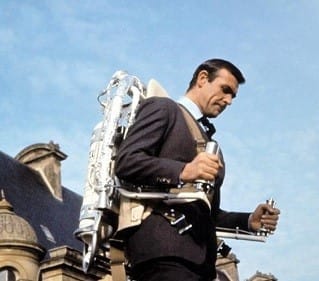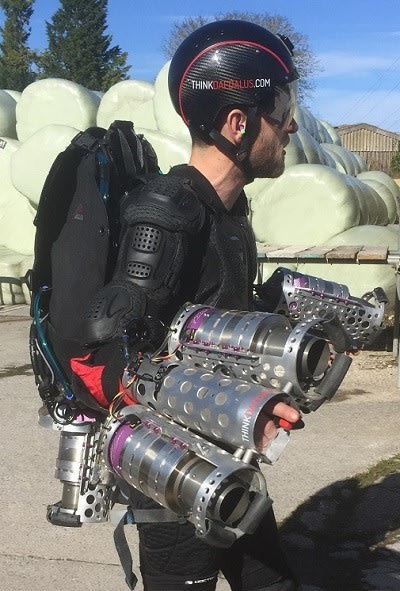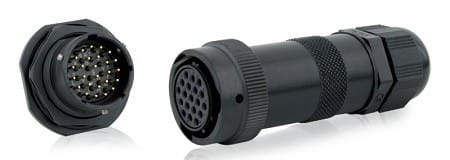How to select the right connector for your jet-pack – and other designs!
Follow articleHow do you feel about this article? Help us to provide better content for you.
Thank you! Your feedback has been received.
There was a problem submitting your feedback, please try again later.
What do you think of this article?
Have you ever watched a movie and asked yourself ‘could I do that?’ That is exactly what Richard Browning was thinking when he watched Tony Stark as Iron Man and decided that he wanted to make a flying suit.
Figure 1: Richard Browning flying his Daedalus suit
There have been experiments with personal flight in the past. In 1965, the world watched James Bond fly a jetpack in Thunderball. The jet pack, known as the Bell Rocket Belt, was the fully functioning result of a US Army programme to give its soldiers mobility on the battlefield. However, the 5 gallons of hydrogen peroxide fuel provided only 21 seconds of flight, and the Army decided to spend its research dollars elsewhere.
Figure 2: James Bond (Sean Connery) with the Bell Jet Belt in 1965
(Image: http://jamesbond.wikia.com)
More recently, there have been several attempts to create the personal flight revolution – just type the phrase ‘personal jet pack’ into a search engine and you will be presented with several companies wishing to sell you such a device. Richard took a different approach and decided to see if he could create his own.
He has been assisted by 50 years of research and development in the fields of engines, fuel, controls and electronics. Modern miniaturised jet engines provide a remarkable amount of thrust for something that is little larger than a big tin of beans (and using much safer fuels than hydrogen peroxide!). Looking at the computing power of something as small as a Raspberry Pi, it should be no surprise that controlling this new generation of engines is easier too, something that would have been science fiction in 1965.
But where do I start?
Nowadays, if you were to ask the question ‘where do I start?’ the answers regarding engines and control are readily available. Potentially the hardest part of the project is how to integrate them into a single, functional device.
Engines need to be connected to their fuel source. HMI (human-machine interface), display and sensor devices need to talk to each other. And everything needs to be linked back to the central electronic brain that controls the whole affair.
You are probably now realising that any system of this complexity will be crammed with other components that, while not as exciting, are just as vital as the engines in keeping Richard in the air.
But how do we choose the products that are going to make Daedalus work? We're going to take a look at some of the connectors and cables that Richard needs, and explain how we can go about selecting suitable components with the help of the RS website. As a result of the breadth of types, applications and capabilities, cables and connectors can present the most confusing range of options. While the Daedalus project is a little unusual, the approach we will take in selecting products is just as valid in more everyday situations.
Define the task
Our first job is to define the task which our product is going to undertake. With a connector or a cable, the questions will be similar: how many conductors will be required, how much current and voltage will be carried, does it need to be shielded? In most cases, the answers to these questions will dictate the overall size of the product.
Next, we need to look at the conditions in which the products need to work. The most frequently encountered question is whether the products will be exposed to water or weather, and hence whether they need to be waterproof. However, there can also be considerations around vibration and shock, and sometimes exposure to chemicals other than ordinary water. When combined, the answers to these questions will dictate the physical design of the connector or cable, and also the materials from which it is created.
Finally, we need to establish if there are any special requirements that affect the product selection. Will the product be handled frequently, or is it a ‘fit and forget’ application? Does the product need to be lightweight? Should the product be colour coded for easy use? The application should make the answers to these (and myriad other) questions fairly obvious, but it is always worth taking a moment to consider the unexpected.
Selecting connectors for special use
Let’s look at a hypothetical situation. A customer is looking for a connector that will be used in a deck-mounted application aboard ship. The design calls for an unshielded circuit with 3 conductors capable of carrying 5 Volts at 0.5 Amps – not extreme in any way, and so a small connector will be ideal. The connector will be installed as the ship is built and, barring failures, will only ever be disconnected during a major overhaul. However, the marine environment is harsh, with salt water and sunlight (and hence exposure to ultraviolet or UV radiation) a constant problem.
In this example, we need a waterproof connector capable of withstanding the elements. As the connector need not be shielded, we can consider a plastic shell. Some plastics are adversely affected by UV radiation, so metal might be a better choice. However, salt water can play havoc with several types of metal, especially aluminium. As an alternative, we could look at stainless steel which would be corrosion resistant. Stainless steel is very hard, making it difficult to work with and as a result is quite expensive. A little research brings us to an alternative – nickel aluminium bronze (NAB) alloy.
Nickel aluminium bronze is a very dense golden-coloured metal. It offers excellent resistance to UV radiation and salt-water corrosion, and the copper component offers an added benefit in that it discourages colonisation by marine organisms – algae, mussels and lichens. It is dense and therefore heavy, but for a marine application, this is rarely a problem.
You get the picture – product selection is often a case of weighing up a number of compromises and identifying the really important features. In this case, resistance to corrosion is more important than weight-saving, so NAB is the right choice.
Selecting connectors for Daedalus
Daedalus has presented Richard with a number of challenges, and Richard has asked us to help. Mounted on each of Richard’s arms is a pair of engines and some hand controls. Under Richard's index finger is a trigger used to control the throttle of the engines. Rather than a simple on-off switch, the trigger is variable, allowing Richard to control the exact amount of power very accurately. Along with other controls, each handgrip needs to link back to the electronics held in the backpack. Each connection requires 5 conductors, each of which has to handle only signal currents at low voltages.
Figure 3: Richard wearing the Daedalus suit. You can see the throttle switch under Richard’s right index finger, and a range of wires and fuel lines at the top of the engines.
There are a number of requirements for this application. As the cable will be fed down the sleeve of the flight suit to the hand, it needs to be flexible and remain so for its entire life. When the cable reaches the handgrip, it will need a connector which can be removed whenever necessary. While Richard's end goal is to refine his suit so that he can step into and out of it easily, the reality of the current design is that the connector will need to be disconnected each time he puts the suit on.
Therefore, the connector needs to be robust and have a long life-expectancy, although waterproofing is not a key requirement. It would be convenient if the connector had a quick release feature, but it still needs to be vibration proof so that it remains safely mated whilst the suit is in use. Finally, as Daedalus has to lift Richard and itself with thrust to spare, any components that we select should ideally be light in weight.
Cables before connectors
In my experience, it is always easier to pick the cable first and then find a connector to fit, rather than the other way round. With this in mind, I started looking into high-flexibility cables and selected a family of cables from Alpha Wire called XTRA-GUARD FLEX.
Figure 4: Alpha Wire XTRA-GUARD FLEX
These cables are designed for highly dynamic applications where they are subjected to constant flexing. I chose a 5 conductor shielded cable (408-895) that is tested up to 6 million flex cycles and uses stranded cores of just 0.14mm2 (26 AWG). This means that the overall diameter of the cable is just 5.36mm. The shield is an aluminium/polyester foil, which helps keep weight to a minimum.
Having selected the cable, I then looked for connectors. Richard is currently using a screw-coupling DIN connector. While perfectly adequate from an electrical point of view, Richard has found these quite large and heavy, and the screw-coupling design cannot be described as ‘quick release’. In addition, they are of a standard commercial grade and are not designed for repeated mating/un-mating cycles. To replace this, he needs a more robust design.
Specialist applications
For many years, the military circular connector has ruled the roost when it comes to this kind of specialist application. They are designed to a wide variety of standards but are all intended to be robust and capable. They are often manufactured of aluminium alloy to provide a light weight suitable for aerospace installations, and over the years they have been adopted by a huge variety of industries, from robotics to automotive.
My initial investigations centred on connectors manufactured to the MIL-DTL-26482 standard. This is a bayonet-fixing connector, making it more ‘quick release’ than the DIN connector currently in use. While they are available in exotic materials like stainless steel, the majority are an aluminium alloy and have the advantage of being available from a wide selection of manufacturers due to the standard nature of their design. Options include Souriau (687-6645) , Glenair (019-0156) and Amphenol (540-4902) .
Figure 5: MIL-DTL 26482 connectors from Esterline Souriau
Looking more carefully, a 5-pole variant of this connector would be mounted in a size 14 shell, with an overall diameter of nearly 30mm. I didn’t consider this slim enough, so I continued searching.
In the industrial sector, there is a type of push-pull connector invented by Swiss manufacturer LEMO. They use a very compact latching design that is secure during use but is very easy to mate and un-mate. This feature makes the whole connector very slim – the plug of the 0B Series is less than 10mm in diameter (433-2351) . Using gold-plated, screw machined contacts, the connectors are intended for repeated use, with an expected life of over 5,000 mating cycles.
Figure 6: B Series Push-Pull Connectors from LEMO
The B series from LEMO looks like the perfect connector for Daedalus – slim, long-lived, robust and quick release – except for one drawback. The shell is usually manufactured from chrome-plated brass, which is not light.
This fact might have been the end of the line, but LEMO has already thought of this. Based on their experience of the Formula 1 market, LEMO has developed the F series. This series combines the advantages of the push-pull B series with some of the features of military circular connectors. The F series uses the same small screw-machined contacts as the B series, but houses them in an aluminium alloy connector that is slim and short, thus reducing weight to a minimum.
Figure 7: F-Series Lightweight Push-Pull Connectors from LEMO
The size 0F connector is still only 12mm in diameter and does away with a backshell to support the cable in favour of a fixing for a heat shrink moulded boot.
Heat shrinks
Heat shrink material is a miracle of modern polymer technology, and a heat shrink moulded boot provides a neat alternative to traditional cable-fixing methods. In Richard’s application, the rear of the 0F connector is about 9mm and the cable diameter is just over 5mm, so I selected a product from HellermannTyton (829-0153) that would create a neat installation that easily fits down the sleeve of Richard's suit. The mated pair of connectors will be no more than 12mm in diameter, and less than 80mm long including the heat shrink boots.

Components are HellermannTyton heat shrink (401-04024) far left and right,
LEMO connector FGN.0F.305.XLC and PHN.0F.305.XLM, centre.
This example perfectly shows how product selection is an exercise in identifying your requirements, concentrating on those that present the biggest challenge or are most important, and finding a connector that provides the best compromise. It may seem like a complicated process, but with a clear view of your key requirements, some common sense and the help of the RS website, you too can find the best solution for your application.
Interview with Richard Browning
We caught up with Richard (safely on the ground!) at his home in Salisbury to discover more about his inspirational journey and where Gravity Industries is going next. We had a lot to talk about, so the interview is broken down into individual questions, below.
- When did the idea to build an HPT system first come to you?
- Can you tell us a bit about your engineering background?
- Did you ever doubt that the Daedalus system would work?
- Can you tell me about the HUD system you’ve developed using the Sony SmartEyeglass?
- How fit do you need to be to ‘pilot’ Daedalus?
- Are we heading for a new mode of personal transport?









